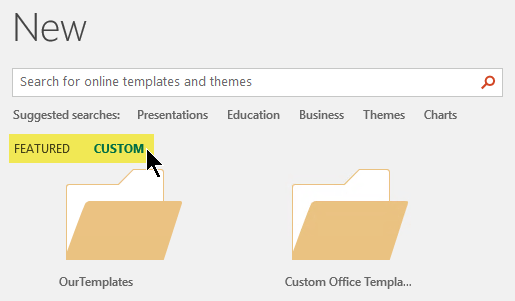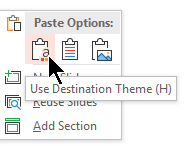Apply a template to an existing presentation
When you want to apply a template, either to a new or existing presentation, start fresh with a blank presentation.
If you need help knowing where to put a template file so you can apply it as described here, see Where template files belong below.
Select a template

- Select File >New.
- Under New, you can navigate to a personal or workgroup template, Search for a template, or choose a featured template or theme from the gallery. To navigate to a personal or workgroup template, select the tab next to Featured, which may be named Personal, Shared, or Custom (depending on the circumstance) and then open the folder that contains the template you want.
Apply the template to existing slides, if any
If you have existing slides, import them into the new file you created above:
- Open the file that contains the existing slides.
- Click the thumbnail pane and then select the slides you want:
| To select this | Do this |
| All slides | Press Ctrl+A |
| A subset of the slides | Press and hold Ctrl while you click the individual slides you want to select |
 select the first option, Use Destination Theme" />
select the first option, Use Destination Theme" />
Copy the selected slides (Ctrl+C).
Switch to the new file, right-click the thumbnail pane, and under Paste Options select Use Destination Theme:
Where template files belong
To be used easily, store a personal template that you've created or a workgroup template for your organization in a standard folder location that Office knows about.
Doing so makes the template available from File > New in PowerPoint from the tab next to the Featured tab.
Personal templates: see or change the default location
- In PowerPoint, go to File >Options >Save.
- Under Save presentations, see the box named Default personal templates location. There may or may not already be a folder location specified in this box. If a folder is specified, we recommend that you continue using it. Place your personal template in this folder. If no folder is specified in that box, we recommend that you use File Explorer to create the following default personal template folder: C:\Users\YourUserName\Documents\Custom Office Templates YourUserName isn't a literal folder name. Use the above folder path name in the Default personal templates location box, but replace YourUserName with whatever your user name is on this computer.
Workgroup templates: see or change the default location
Organizations often have a standard network or cloud location where templates are stored for everyone to have access to. Office calls them workgroup templates .
In some cases, no location is specified for Workgroup templates. Continue with the next steps to establish a default location.
- Open any .docx file in Word.
- Select File >Options >Advanced >File Locations. (Scroll down towards the bottom to the General section to find the File Locations button.)
- In the File Locations dialog box, note the location specified for Workgroup templates.
- If a location name is cut off, select it and click Modify to open a dialog box that will show the full location.
- In some cases, no location is specified for Workgroup templates. Continue with the next steps to establish a default location.
- To change the default location, select it, and then click Modify.
- In the dialog box that opens, navigate to the folder you want to specify as the default location, and then click OK. In the case of workgroup templates for a large organization, they are typically stored in a network location that all users have access to. For example, the Contoso Consulting company might have a server named "Contoso" with a folder structure like this for templates: \\Contoso\Files\OfficeTemplates.
Start from a custom template
To create a new presentation from a custom template, follow the procedures below.
- Select File >Open.
- Navigate to the folder where the template file is stored.
- Select the template file and then click Open.
- Select File >Save As.
- In the dialog box, type a name for your new presentation in the Save As box.
- In the File Format box, choose PowerPoint Presentation (.pptx).
- In the Where box, select the folder you want to save the presentation in.
- If you don't have existing slides to import, simply begin creating slides in your new file. If you have some existing slides that you want to apply the template to, see the section Apply the new template to existing slides below.
Start from a standard Microsoft template
To create a new presentation from a standard PowerPoint template
- Select File >New from Template.
- Choose a template from the Gallery, then click Create.
- If you don't have existing slides to add to the new presentation, simply begin creating slides in your new file. If you don't have existing slides to add to the new presentation, see the next section.
Apply the new template to existing slides, if any
If you have existing slides, import them into the new file you created above:
- Open the file that contains the existing slides.
- Click the thumbnail pane and then select the slides you want:
| To select this | Do this |
| All slides | Press |
Why it's best to start fresh when applying a template
Even if you have existing slides, we recommend that you apply a template to it by starting fresh with the template and then importing the existing slides into the new, fresh template. This process helps to ensure that everything in your presentation (especially things you haven't created yet) adopts the look and formatting prescribed by the template.



 select the first option, Use Destination Theme" />
select the first option, Use Destination Theme" />